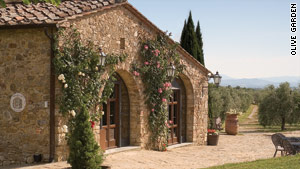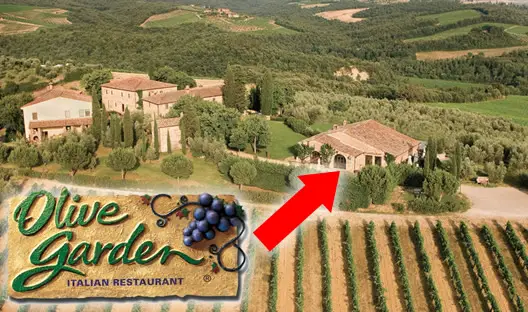Tuscany is known for its stunning landscapes and rich cultural heritage. Among its many treasures, the olive gardens stand out.
Imagine strolling through lush olive groves, where ancient trees whisper tales of history. Tuscany’s olive gardens offer more than just beauty; they provide a connection to nature and tradition. These serene spots are perfect for relaxation and exploration. You can taste fresh olive oil, learn about the cultivation process, and enjoy the peaceful surroundings.
Whether you’re a nature lover or a history enthusiast, an olive garden in Tuscany is a must-visit. The experience is not only enriching but also soothing for the soul. Discover why these gardens are a cherished part of Tuscany’s charm.
JUMP TO TOPIC
Introduction To Olive Gardens
Olive gardens in Tuscany are a sight to behold. They stretch over rolling hills, creating a picturesque landscape. These gardens are not just beautiful. They are a vital part of Tuscany’s history and culture. Let’s explore why olive gardens are so special in this region.
Brief History
Olive trees have grown in Tuscany for thousands of years. Ancient Romans cultivated these trees for their precious oil. This tradition has continued through the centuries. Families passed down their olive groves through generations. Today, some of these groves are hundreds of years old.
Cultural Significance
Olive gardens hold a special place in Tuscan culture. They symbolize peace, prosperity, and tradition. Many local festivals celebrate the olive harvest. People gather to pick olives and press them for oil. This oil is then used in almost every Tuscan dish. It is a staple in the local cuisine.
The process of growing and harvesting olives is a craft. It requires skill and dedication. This deep connection to the land and its produce is a source of pride for Tuscans. Olive gardens are more than just farms. They are a testament to the region’s rich heritage.
Tuscany’s Olive Garden Landscape
Tuscany’s Olive Garden Landscape is a breathtaking sight. This region is famous for its rolling hills and lush olive groves. The landscape is a blend of natural beauty and human cultivation. These gardens have been nurtured for centuries.
Geographical Features
The geographical features of Tuscany are unique. Rolling hills stretch as far as the eye can see. Olive trees dot the landscape. The soil here is fertile and rich in minerals. This makes it perfect for growing olives. The terrain also includes valleys and small mountains.
Many gardens are on terraced slopes. This helps to protect the soil from erosion. It also allows for better water management. These terraces are a testament to human ingenuity and hard work.
Climate Conditions
The climate in Tuscany is ideal for olive cultivation. It has a Mediterranean climate. This means mild winters and hot, dry summers. Olive trees thrive in these conditions. They need lots of sunlight and well-drained soil.
Rainfall is moderate but enough for the trees to flourish. The unique climate contributes to the quality of the olives. These conditions help produce olives with a rich, robust flavor. This makes Tuscany’s olive oil some of the best in the world.
Cultivation Of Olives
Olive Garden in Tuscany is a treasure trove of rich flavors and ancient traditions. The cultivation of olives is a practice that dates back centuries, blending both traditional and modern techniques. This combination ensures the highest quality of olives, resulting in the exquisite olive oil Tuscany is famous for.
Traditional Methods
Traditionally, olives in Tuscany are grown on terraced hillsides. These terraces help prevent soil erosion and allow for better water management. Farmers often use hand tools and animal labor to tend to the olive trees.
Harvesting is a family affair, with everyone pitching in. Olives are picked by hand or with the help of small rakes. This gentle method ensures that the olives are not damaged, preserving their quality.
Have you ever tasted olive oil straight from the press? It’s an unforgettable experience that connects you directly to the land and its history. Traditional methods are all about maintaining that connection.
Modern Techniques
In recent years, modern techniques have been introduced to olive cultivation in Tuscany. These methods aim to enhance efficiency without compromising quality. Drip irrigation systems, for instance, ensure that each tree receives the right amount of water.
Mechanical harvesters are now used in some areas, speeding up the process and reducing labor costs. These machines are designed to be gentle, mimicking the hand-picking process to avoid damaging the olives.
Technology also plays a role in monitoring the health of the olive trees. Drones and sensors can detect issues like pests or diseases early on, allowing for prompt action. This proactive approach helps maintain the high standards of Tuscan olive oil.
Have you considered how these modern techniques might affect the flavor of your olive oil? While some purists prefer the traditional methods, many producers find that a blend of both old and new techniques yields the best results.
Which method do you think produces the best olive oil? Share your thoughts in the comments below!

Credit: www.cnn.com
Types Of Olive Trees
Olive Garden in Tuscany features diverse olive trees. Frantoio, Leccino, and Moraiolo are popular varieties grown here. Each type offers unique flavors and textures, enhancing the region’s renowned olive oil.
When you think of Tuscany, the first thing that might come to mind is its picturesque olive gardens. The region’s olive trees are a testament to time, each one contributing to the rich history and culture of olive oil production. But did you know there are different types of olive trees in Tuscany? Understanding these varieties can enhance your appreciation of this timeless landscape.Common Varieties
In Tuscany, you will often come across the Frantoio, Leccino, and Moraiolo olive trees. These are the backbone of Tuscan olive oil. Frantoio trees are known for producing high-quality oil with a fruity flavor. The olives are medium-sized and turn black when they ripen. Leccino trees are hardy and resistant to cold. Their olives are smaller, but they produce a light, sweet oil that many people love. Moraiolo trees are quite unique. They thrive in rocky soils and produce small, round olives. The oil from these olives has a robust, peppery taste. Have you ever tasted the difference between these oils? Next time you’re in Tuscany, try sampling them side-by-side. You might find a new favorite!Unique Species
Beyond the common varieties, Tuscany is home to some unique olive species that are less well-known but equally fascinating. Pendolino trees are often used as pollinators for other olive varieties. The olives are small and the oil is mild, making it perfect for blending. Maurino trees are another rare find. They produce a delicate oil with a floral aroma. This oil is often used in gourmet cooking. Coratina trees, while not native to Tuscany, have been adopted by some local farmers. They produce a strong, bitter oil that adds a punch to any dish. Why not take a stroll through an olive garden and see if you can spot these unique trees? It’s a great way to connect with the land and its history. Have you ever wondered how the type of olive tree affects the taste of the oil? It’s a fascinating topic to explore and one that can deepen your appreciation for this ancient craft. So, next time you find yourself in Tuscany, take the time to learn about the different types of olive trees. It will make your visit even more memorable.Olive Harvesting
Olive harvesting in Tuscany is a cherished tradition. Families gather to pick olives from ancient trees. This process is vital for producing high-quality olive oil. The methods used today have been passed down through generations. Below, we explore the harvest seasons and techniques used in Tuscany.
Harvest Seasons
In Tuscany, olive harvest season starts in late October. It lasts until early December. The timing depends on the olive ripeness. Green olives are picked first. They produce a more bitter oil. As the season progresses, black olives are harvested. These yield a smoother, milder oil.
Harvesting Techniques
Traditional methods are still popular in Tuscany. Hand-picking is common. Workers use small rakes to comb through branches. This ensures minimal damage to the trees. Some use nets spread under trees. Olives fall into these nets, making collection easier.
Modern methods include mechanical harvesters. These machines shake the trees gently. Olives fall into attached collectors. This speeds up the process. Yet, many farmers prefer hand-picking. It keeps the tradition alive and ensures quality.

Credit: www.gimmesomeoven.com
Olive Oil Production
Olive oil production in Tuscany is a time-honored tradition. The region’s rolling hills and sunny climate provide the perfect environment. Tuscan olive oil is known for its rich flavor and high quality. This unique oil is a staple in many kitchens worldwide.
Extraction Process
The extraction process begins with hand-picking olives from the trees. Harvesting typically takes place from October to December. The olives are then cleaned to remove leaves and dirt. They are crushed into a paste using large stone mills. This traditional method preserves the olive’s natural flavors.
Next, the paste goes through a process called malaxation. It is slowly mixed to release the oil droplets. The mixture is then put into a centrifuge. This separates the oil from water and solid residues. Finally, the oil is filtered to remove any remaining impurities.
Quality Standards
Tuscan olive oil must meet strict quality standards. These standards ensure the oil’s purity and taste. The olives used must be grown in Tuscany. The oil should be cold-pressed. This means it is extracted without heat to preserve its nutrients. The acidity level must be below 0.8% to qualify as extra virgin.
Producers often have their oil tested in laboratories. This ensures it meets all required standards. The oil is also tasted by experts. They check for flavor, aroma, and other characteristics. Only the best oils receive the designation of extra virgin olive oil.
Visiting Olive Gardens
Visiting olive gardens in Tuscany is a unique experience. The region is famous for its beautiful landscapes and rich history. Olive gardens here offer a peaceful escape and a taste of local culture. Each visit promises new discoveries and lasting memories.
Tourist Attractions
Tuscany is home to many tourist attractions. Olive gardens are among the most popular. Visitors can explore the lush groves and learn about olive oil production. Many gardens offer guided tours. These tours include tastings of fresh olive oil. Some gardens also have historical sites nearby. These sites provide insight into the region’s past.
Local Experiences
Local experiences in Tuscany go beyond the typical tourist spots. Visiting olive gardens allows you to connect with the land. You can meet local farmers and hear their stories. Some gardens offer cooking classes. These classes teach you how to use olive oil in traditional dishes. You can also take part in the olive harvest. This hands-on activity is both fun and educational.
Staying in a countryside villa adds to the experience. Many villas are surrounded by olive gardens. Waking up to the sight of olive trees is a treat. The fresh air and serene setting are perfect for relaxation. Many visitors find this experience unforgettable.
Sustainable Practices
The Olive Garden in Tuscany is a perfect example of sustainable practices. This beautiful garden showcases how to grow olives while caring for the environment. The garden uses methods that benefit both the land and the people. Let’s explore some of these practices.
Environmental Impact
The Olive Garden in Tuscany minimizes its environmental impact. It uses water wisely and preserves soil health. The garden also promotes biodiversity, ensuring a balanced ecosystem. Wildlife thrives in this well-maintained environment. This approach ensures long-term sustainability.
Organic Farming
Organic farming is a key practice in the Olive Garden. The garden avoids synthetic chemicals. Instead, it uses natural fertilizers and pest control. This keeps the olives free from harmful residues. Organic farming also improves soil quality. The result is healthier plants and better olives.

Credit: www.lecremedelacrumb.com
Frequently Asked Questions
Are There Any Olive Gardens In Italy?
Yes, Italy has many olive gardens. They are famous for producing high-quality olives and olive oil.
Are There Olive Groves In Tuscany?
Yes, Tuscany has many olive groves. The region is famous for its high-quality olive oil production. Tuscany’s climate and soil are ideal for growing olives. Visitors can tour groves and taste fresh olive oil.
Which Countries Have Olive Garden?
Olive Garden is in the United States, Canada, Mexico, Brazil, and Kuwait. These countries have Olive Garden restaurants.
What Is The Most Popular Food In Tuscany Italy?
Ribollita is the most popular food in Tuscany, Italy. This hearty soup contains bread, beans, and vegetables.
Conclusion
An olive garden in Tuscany offers a serene escape. The beauty of the landscape, the taste of fresh olives, and the peaceful atmosphere create a perfect retreat. Visiting Tuscany’s olive gardens provides a unique experience. Enjoy nature, savor local flavors, and find relaxation.
Plan your visit to experience the charm yourself. Tuscany awaits with its timeless appeal. Discover the magic of an olive garden in this beautiful region. Your adventure in Tuscany promises unforgettable memories.

